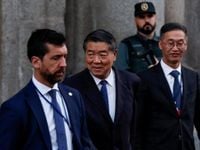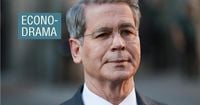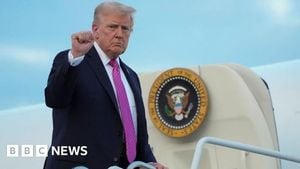Trade tensions between the United States and China are once again at the center of the global economic stage, as officials from both countries gather in Madrid for a high-stakes round of negotiations. The talks, which began on Sunday, September 14, 2025, at the historic Santa Cruz Palace, are scheduled to continue through Wednesday, September 17. With the world’s two largest economies at loggerheads over tariffs, industrial overcapacity, and the fate of the popular video-sharing app TikTok, the outcome of these discussions could ripple far beyond the negotiating table.
Leading the U.S. delegation is Treasury Secretary Scott Bessent, joined by Jamieson Greer, while China’s team is headed by Vice Premier He Lifeng. According to Al Jazeera, the first day saw six hours of intense conversation, signaling the seriousness with which both sides are approaching the talks. The agenda is packed: trade imbalances, accusations of industrial overproduction, and the looming TikTok deadline all demand urgent attention. The backdrop, however, is a recent history of tit-for-tat tariffs and escalating rhetoric that has left businesses and consumers on both sides feeling the pinch.
One of the most contentious issues on the table is China’s so-called “structural overproduction”—the practice of producing more goods, particularly in sectors like steel and solar panels, than can be absorbed by the domestic or global market. On Friday, September 12, Democrats in Washington sent a pointed letter to Scott Bessent, urging him to confront Beijing on this issue during the Madrid talks. The letter, obtained by Reuters, called for “binding requirements” that would force China to scale back its industrial output. Lawmakers wrote, “The PRC’s historic and destructive use of structural overproduction to drive economic growth comes at an indisputable cost to U.S. industry, employment, and the stability of international markets.” They also highlighted that the problem affects not just the United States, but allies such as Japan and South Korea, who face waves of low-cost Chinese exports undermining their own industries.
While concerns about Chinese overcapacity are nothing new—former Treasury Secretary Janet Yellen raised similar alarms during the Biden administration—what’s changed is the political context. With Donald Trump back in the White House, Democrats are keen to ensure the issue stays front and center. They also urged the administration to take a “more balanced” approach to tariffs, noting that some previous decisions had hit U.S. allies harder than Beijing.
The Trump administration’s use of tariffs as a primary economic weapon dates back to 2017. While some duties have been eased under certain conditions, the overall environment remains fraught. Currently, the U.S. imposes a 30 percent tariff on Chinese imports, while China levies a 10 percent duty on U.S. goods. In some sectors, such as medical supplies and steel, real rates are even higher. The two sides recently agreed to extend a pause on tariffs of up to 145 percent for another 90 days, but that truce is set to expire on November 10, 2025. As the deadline approaches, pressure is mounting for a breakthrough—or at least a further extension.
Another flashpoint is China’s purchase of Russian oil, a move that has drawn sharp criticism from Washington. President Trump has been pushing U.S. allies to impose steep tariffs on both China and India in response to their continued energy trade with Moscow. In a recent post on his Truth Social platform, Trump argued, “China has a strong control, and even grip, over Russia, and these powerful Tariffs will break that grip.” He has already raised tariffs on Indian goods to 50 percent, but so far China has avoided similar measures. Trump’s team has also unveiled plans to urge G7 countries to consider tariffs of up to 100 percent on China and India unless they cut off Russian oil purchases. During a Fox News interview last Friday, Trump stated his patience with Vladimir Putin is “running out fast,” hinting at further actions, including banking sanctions and oil tariffs.
China, for its part, has not taken these moves lying down. On Saturday, September 13, Chinese Foreign Minister Wang Yi publicly criticized Washington’s sanctions approach, arguing that such measures would only “complicate” the situation in Ukraine. In a further sign of escalating tensions, China’s Ministry of Commerce launched new investigations into the U.S. chip sector after the U.S. Department of Commerce added 23 more Chinese entities to its restricted trade list.
Beyond tariffs and oil, the fate of TikTok looms large over the Madrid talks. ByteDance, the China-based parent company of TikTok, faces a Wednesday, September 17 deadline to divest its U.S. operations or see the app banned in the United States. The ban was included in legislation passed last year with overwhelming bipartisan support. Trump has delayed enforcement three times, and according to Cryptopolitan, he is likely to extend the deadline again, keeping the app’s future in limbo. Deborah Elms, head of trade policy at the Hinrich Foundation in Singapore, told Al Jazeera, “If they can bundle something together, I would think they will try to promise to resolve TikTok by the end of Trump’s term. Extending the deadline for less than that just leads to new deadlines which are also likely to be problematic.”
The current round of talks in Madrid is just the latest in a series of meetings this year, with previous sessions held in Geneva, London, and Stockholm. Each meeting has ended with incremental progress, but a comprehensive deal remains elusive. Heiwai Tang, director of the Asia Global Institute in Hong Kong, observed, “China has rare earth and the manufacturing capacity that the US needs, while the US has the market that China can’t easily replace with another one. So both have some bargaining power against each other.” Tang also predicted that tariffs might be lowered within a year as rising prices become a bigger issue in the U.S., but cautioned, “Economists are not good at predicting the exact timing of events. If you ask me, it will be very likely that both sides will lower tariffs on each other in less than a year’s time.”
Looking ahead, both sides seem to be eyeing a possible summit between President Trump and Chinese President Xi Jinping, potentially on the sidelines of the Asia-Pacific Economic Cooperation (APEC) summit in South Korea at the end of October. Deborah Elms commented, “I think there is a strong interest in getting Trump and Xi together in a matter of weeks. That is likely to be high on the agenda for both sides.”
With the stakes so high and the issues so complex, the world is watching Madrid closely. Whether these talks will yield a breakthrough or simply kick the can down the road remains to be seen, but one thing is clear: the U.S.-China economic relationship is at a crossroads, and the decisions made this week will shape global commerce for years to come.





